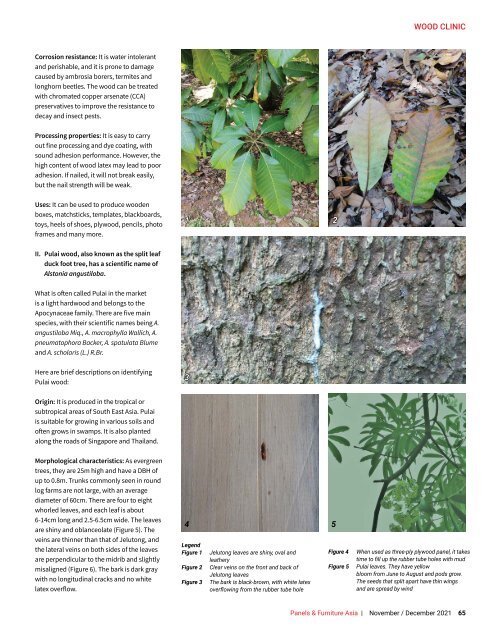Panels & Furniture Asia November/December 2021
Panels & Furniture Asia (PFA) is a leading regional trade magazine dedicated to the woodbased panel, furniture and flooring processing industry. Published bi-monthly since 2000, PFA delivers authentic journalism to cover the latest news, technology, machinery, projects, products and trade events throughout the sector. With a hardcopy and digital readership comprising manufacturers, designers and specifiers, among others, PFA is the platform of choice for connecting brands across the global woodworking landscape.
Panels & Furniture Asia (PFA) is a leading regional trade magazine dedicated to the woodbased panel, furniture and flooring processing industry. Published bi-monthly since 2000, PFA delivers authentic journalism to cover the latest news, technology, machinery, projects, products and trade events throughout the sector. With a hardcopy and digital readership comprising manufacturers, designers and specifiers, among others, PFA is the platform of choice for connecting brands across the global woodworking landscape.
You also want an ePaper? Increase the reach of your titles
YUMPU automatically turns print PDFs into web optimized ePapers that Google loves.
WOOD CLINIC<br />
Corrosion resistance: It is water intolerant<br />
and perishable, and it is prone to damage<br />
caused by ambrosia borers, termites and<br />
longhorn beetles. The wood can be treated<br />
with chromated copper arsenate (CCA)<br />
preservatives to improve the resistance to<br />
decay and insect pests.<br />
Processing properties: It is easy to carry<br />
out fine processing and dye coating, with<br />
sound adhesion performance. However, the<br />
high content of wood latex may lead to poor<br />
adhesion. If nailed, it will not break easily,<br />
but the nail strength will be weak.<br />
Uses: It can be used to produce wooden<br />
boxes, matchsticks, templates, blackboards,<br />
toys, heels of shoes, plywood, pencils, photo<br />
frames and many more.<br />
1<br />
2<br />
II. Pulai wood, also known as the split leaf<br />
duck foot tree, has a scientific name of<br />
Alstonia angustiloba.<br />
What is often called Pulai in the market<br />
is a light hardwood and belongs to the<br />
Apocynaceae family. There are five main<br />
species, with their scientific names being A.<br />
angustiloba Miq., A. macrophylla Wallich, A.<br />
pneumatophora Backer, A. spatulata Blume<br />
and A. scholaris (L.) R.Br.<br />
Here are brief descriptions on identifying<br />
Pulai wood:<br />
3<br />
Origin: It is produced in the tropical or<br />
subtropical areas of South East <strong>Asia</strong>. Pulai<br />
is suitable for growing in various soils and<br />
often grows in swamps. It is also planted<br />
along the roads of Singapore and Thailand.<br />
Morphological characteristics: As evergreen<br />
trees, they are 25m high and have a DBH of<br />
up to 0.8m. Trunks commonly seen in round<br />
log farms are not large, with an average<br />
diameter of 60cm. There are four to eight<br />
whorled leaves, and each leaf is about<br />
6-14cm long and 2.5-6.5cm wide. The leaves<br />
are shiny and oblanceolate (Figure 5). The<br />
veins are thinner than that of Jelutong, and<br />
the lateral veins on both sides of the leaves<br />
are perpendicular to the midrib and slightly<br />
misaligned (Figure 6). The bark is dark gray<br />
with no longitudinal cracks and no white<br />
latex overflow.<br />
4 5<br />
Legend<br />
Figure 1<br />
Figure 2<br />
Figure 3<br />
Jelutong leaves are shiny, oval and<br />
leathery<br />
Clear veins on the front and back of<br />
Jelutong leaves<br />
The bark is black-brown, with white latex<br />
overflowing from the rubber tube hole<br />
Figure 4<br />
Figure 5<br />
When used as three-ply plywood panel, it takes<br />
time to fill up the rubber tube holes with mud<br />
Pulai leaves. They have yellow<br />
bloom from June to August and pods grow.<br />
The seeds that split apart have thin wings<br />
and are spread by wind<br />
<strong>Panels</strong> & <strong>Furniture</strong> <strong>Asia</strong> | <strong>November</strong> / <strong>December</strong> <strong>2021</strong> 65


















